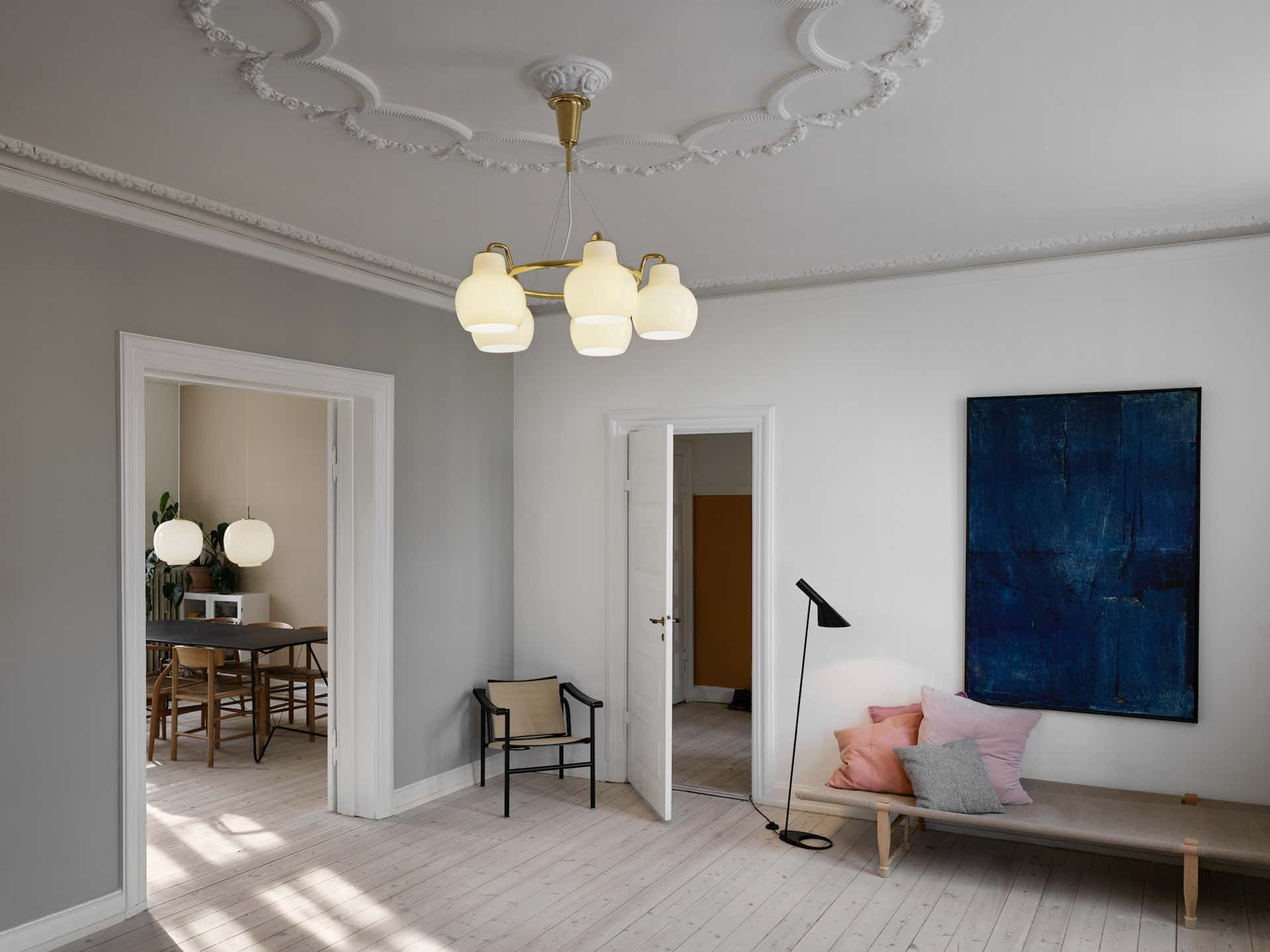Designed by Vilhelm Lauritzen in the 1940s, the VL Ring Crown lamp is a flagship collection in the history of Danish design, which is available in several wall and pendant formats.
Its very rounded lampshades are reminiscent of the aesthetics of the VL38 series. The combination of 3-layer hand-blown glass and untreated brass structures gives the VL Ring Crown lighting fixtures a look that is both simple and luxurious, which allows it to fit into all interior styles.
Untreated brass will develop a beautiful patina over time, giving additional character to the lamp.
VL Ring Crown is available in pendants with 3, 5 or 7 lampshades and as a wall lamp with 1 or 2 lampshades.

Materials Three-layer polished opal blown glass shade. Support and canopy in untreated matte brass (will acquire a patina over time).
Light source E27
Weight suspension 1 lampshade 1.2kg – 3 lampshades 4.7kg – 5 lampshades 6.7kg – 7 lampshades 9.5kg
VL Ring Crown 1
VL Ring Crown 3
VL Ring Crown 5
VL Ring Crown 7
VL Ring Crown 1
VL Ring Crown 2
Vilhelm Lauritzen
Vilhelm Lauritzen (1894–1984) is one of the most significant architects in the history of Denmark; he was the trail-blazing figurehead of Danish functionalism. A number of his buildings – Nørrebro Theatre (1931–32), Daells Varehus department store (1928–35), Radiohuset (1936-41) and the first airport built in Kastrup (1937–39) – represented the concentrated essence of contemporary life. Other significant buildings to stem from Lauritzen’s drawing board include Folkets Hus (1953–56) better known today as the Vega concert venue, the Shellhuset (1950–51) building and the Danish embassy in Washington (1958–60). In particular the Radiohuset building and the earliest version of Kastrup Airport – both listed today – are considered peerless monuments to modernism in the European genre of construction.
Throughout his life, Vilhelm Lauritzen adhered to the principle that architecture is applied art – with equal emphasis on both ‘art’ and ‘applied’. “No life without aesthetics” was another one of Vilhelm Lauritzen’s firmly held beliefs.
Vilhelm Lauritzen mastered both daylight and artificial lighting. He consistently involved daylight in his architectural projects by including large south- and west-facing windows that neatly mixed warm sunlight with the cooler sky light flowing in through windows facing north and east. It was an approach that shifted focus from the limited wall surfaces in the room itself. People, furnishings and fittings are highlighted and shaded in the sculptural light.
Lauritzen’s fixtures light up with the same idea. They combine strongly directed light that produces sharp shadows with a gentler, more diffuse illumination that softens and shades the rooms.
The first light fitting Vilhelm Lauritzen designed was created in 1926–29 for Fritzsches Glashandel and named the Universal pendant. As a true functionalist, Vilhlem Lauritzen dedicated his entire life to continuing to develop and improve his light fixtures.
Vilhelm Lauritzen’s first fixtures, which he designed for Radiohuset, started to appear in Louis Poulsen catalogues in the middle of the 1940s.
In the 1950s – in step with the progress on his major construction assignments – the Lauritzen range expanded to comprise a broad, varied selection of fittings.
Price Guarantee
Offering design at the right price is an integral part of our work. If you find the same item at a lower price at another retailer, delivery included, we will not only match it, but even offer you a better price.
How to take advantage of it?
We compare our prices every day with all authorized retailers in Europe. If nevertheless you find cheaper, contact us for a counter-proposal.
We must be able to verify that the item is authentic, new, perfectly identical (size, materials, color, etc.)
and that it is not part of a campaign or temporary destocking.
The valid basis is, for example, a current quote or a direct link to another retailer's website where the lower price is indicated. An email image is invalid, the original email must be forwarded.
The offer does not apply to orders already placed and cannot be combined with any of our other offers or promotions.